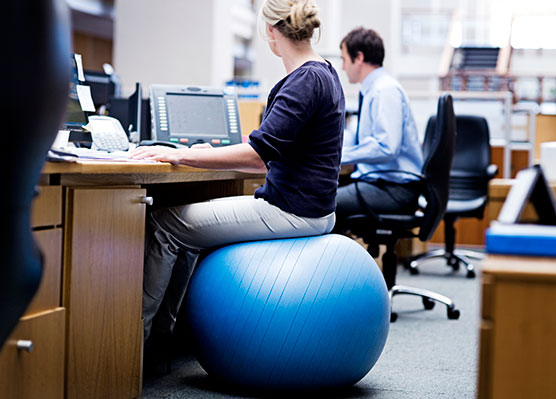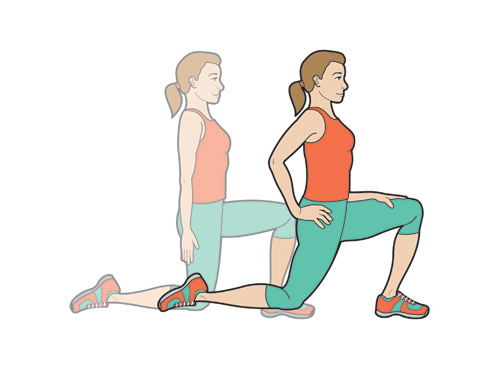Are you experiencing back pain from sitting all day?
Most jobs require a lot of sitting and looking at a computer screen. While that may be great for your bank account, it may be wreaking havoc on your overall health. Not only are you creating muscle tension in your neck, back, arms, and legs. But, prolonged sitting increases your risk of heart disease, diabetes, obesity, and more.
From Head to Toe
What exactly is happening to your body when you sit for hours? Of course, back pain from sitting all day is the number one symptom, but sitting can cause other aches and pains, such as:
- Organ Damage: Muscles are burning less fat and blood becomes sluggish during long hours of sitting. This allows things like fatty acids to clot easily. Prolonged sitting is also linked to high blood pressure and elevated cholesterol. These issues lead to heart disease.
- Muscle Degeneration: Mushy abs, tight hips, limp glutes can lead to overstrained back muscles and impact your balance.
- Foggy Brain: When you move your muscles, fresh blood and oxygen pump to the brain and trigger all sorts of brain activity and mood enhancing chemicals. When you sit for long periods, it can cause everything to slow down, including brain function.
- Neck and Shoulders, Knees and Toes: Strained neck, sore shoulders, slumping posture, and leg cramps can cause all sorts of havoc including poor blood circulation, vertebrae imbalances, and more.
- Bad Back: When sitting for long periods the spine becomes inflexible, disks are squished unevenly, and collagen hardens around supporting tendons and ligaments.

So, what are the threats you face at your desk?
Four the common problems you may be experiencing if you sit at a desk all day is backaches, shoulder and neck pain, sore wrists and tight hips. But, alleviating these pains can be as simple as spending fifteen minutes stretching, standing, or walking. Check out what you can do:
Hunching Your Back as You Work
When you’re slumping in your chair, you are putting your back out of alignment. This poor posture can contribute to chronic ailments such as lower back pain, neck pain, arthritis, and bursitis. Long lasting effects aside, short-term problems are that ongoing back pain stops you from performing your best because you are concentrating on your aches.
While you can relieve tension as you sit, it’s best to configure your workplace setting to support good posture. You can do things like sitting on something wobbly. An exercise ball is an excellent option. Sitting on an exercise ball or even a backless stool will force your core muscles to work. Sit up straight, place both feet on the floor in front of you and jump back into those spreadsheets!
Don’t Neglect Your Neck and Shoulders
Along with hunching your back, when your computer screen is too far away, you may find yourself jutting your neck forward–causing tension to build in your neck and upper back. You might not notice for a while, but once you have strained your shoulders and neck, you’ll be feeling it all the time. You may already realize this but, your shoulder is not just a joint on it own. Its connected to the neck, ribs, and scapula (shoulder blade). If one of those things is out of whack, it can affect the others!
Here are four stretches you should do every hour or so while working:
- Neck Rolls: Simple right? Tilt your head to the right. Slowly roll down and to the left. Reverse back to the right. Do this five times. Only roll your head sideways to the left and right and down. Never roll back for it places pressure on the spine.
- Cow Face Stretch: Reach up with your right arm. Bend the elbow and let the hand fall behind your head. Then move the left arm behind your back and bend at the elbow reaching to rest against the right shoulder blade. Reach to grab the right-hand’s fingertips. Repeat on the other side.
- Standing Wall Stretch: Stand up and placing both hands on a wall so they are at a 90-degree angle to your body. Walk your feet back until arms are straight and bow, bending with a flat back forward at the hips. Make sure not to push against the wall or raise your arms too high. Keep shoulder blades set back and avoid scrunching shoulders around your neck.
- Shoulder Rolls: Roll your shoulders forward 10 times. Reverse, rolling shoulders backward 10 times.
- Finally, you should adjust your workspace so that your keyboard and computer are close enough for you to concentrate on while keeping your back and head straight.

Your Aching Wrists
Neglecting proper wrist positioning while you type emails, reports, or what have you, can lead to serious problems. Your tendons are moving back and forth with every keystroke and mouse click. Improper placement of your hands can cause those muscles to create friction, fatigue, and even inflammation. Such painful results are called microtrauma, and repeated instances can lead to carpal tunnel syndrome.
Make sure your posture is allowing the right amount of blood flow to your hands and fingers. That means keeping your wrists floating horizontally, rather than resting on your desk. Don’t forget to take breaks!
Tight Hips
Sitting all day will shorten your hip flexor muscles. This group of muscles, when tight, will contribute to that lower back soreness we discussed earlier. To prevent this from happening, make sure you are standing frequently and taking necessary breaks to keep your blood moving.
Try taking short walks during your lunch break! Not only will you get the blood flowing in your body but it will help you focus better.
At work or home, you can also stretch your hip flexors. Kneel on your left knee, while bending your right knee. Keep your back straight and shoulders in line with your hips. Swap to your right leg, bending the left knee forward. Stretch each side for about three minutes.

Chiropractic Adjustments
While there are stretches, workouts, and gadgets that can help ease the tension in your muscles and back pain from sitting all day, consistency is key! Alongside stretches and working out, regular chiropractic adjustments can help you heal long-term strains from sitting long periods of time. Dr. Stanlick and our team take pride in giving you the care your body needs to function healthily. Our treatments here at the office will effectively alleviate your aches and pains while correcting chronic ailments. Our “whole body” approach can eliminate the need for pain medications, and you’ll experience your body healing itself. That is how you’ll achieve long-term relief.


